- eISSN 2353-8414
- Tel.: +48 22 846 00 11 wew. 249
- E-mail: minib@ilot.lukasiewicz.gov.pl
Wykorzystanie wideo marketingu w strategii komunikacji uczelni biznesowej
Mirosława Pluta-Olearnik1, Alisa Hasiak2
1 Department of Marketing, Wroclaw University of Economics and Business,
Komandorska 118/120, 53-345 Wrocław, Poland
2 Faculty of Management, Wroclaw University of Economics and Business,
Komandorska 118/120, 53-345 Wrocław, Poland
1 E-mail: miroslawa.pluta-olearnik@ue.wroc.pl
ORCID: 0000-0002-5719-4710
2 E-mail: alisa.hasiak@umw.edu.pl
ORCID: 0009-0002-1037-8720
DOI: 10.2478/minib-2024-0021
Abstrakt:
Niniejsze badanie analizuje rolę wideo marketingu w strategiach komunikacyjnych polskich uczelni biznesowych, które funkcjonują na konkurencyjnym rynku szkolnictwa wyższego. Badanie obejmuje praktyki pięciu wiodących polskich szkół biznesu, porównując je z London Business School (LBS), jedną z czołowych europejskich instytucji edukacyjnych. Wykorzystano metody jakościowe, takie jak przegląd literatury, studia przypadków oraz analiza porównawcza, aby zidentyfikować kluczowe elementy skutecznego wideo marketingu, takie jak prezentacje kampusów, wywiady, nagrania wydarzeń oraz treści promocyjne. Sformułowane wnioski mogą posłużyć uczelniom do doskonalenia strategii marketingowych. Artykuł zawiera również propozycje działań, które mogą przyczynić się do zwiększenia efektywności komunikacji marketingowej w instytucjach edukacyjnych.
MINIB, 2024, Vol. 54, Issue 4
DOI: 10.2478/minib-2024-0021
Str. 49-64
Opublikowano 16 grudnia 2024

Wykorzystanie wideo marketingu w strategii komunikacji uczelni biznesowej
1. Introduction
Today’s educational landscape is characterized by the rapid development of technology and the growing role of social media as key communication and promotional tools. Higher education institutions, including those with a business focus, are increasingly turning to advanced marketing strategies to attract prospective students, increase engagement with the academic community and strengthen their position in the competitive education market. One of the most popular tools in this context is video marketing, which allows complex information to be communicated in an attractive and accessible way, while building an emotional connection with the audience.
This study examines the effectiveness of video marketing activities undertaken by the top Polish business universities and their impact on audience perception and engagement. The qualitative research used the case studies of five leading Polish business schools, benchmarking them against the practices of London Business School, one of Europe’s leading business schools.
The findings may be useful for universities aiming to improve their operating strategies. The article also includes practical recommendations for measures to improve the effectiveness of marketing communication efforts within educational institutions.
2. Literature review
Defining an organization’s goals in relation to customer and market needs, rather than focusing solely on the organization itself, has now become more important than ever. Marketing, as the mechanisms for achieving such alignment, has been empowered by a powerful tool: the Internet. The Internet not only facilitates the dissemination of information but also acts as a means for collaboration and interaction among users (Królewski & Sala, 2021; Berman, 2014).
E-marketing is defined as a set of informational activities aimed at meeting the needs of individuals as well as collective needs within the electronic market, using information technology to gain a competitive advantage and increase profits for businesses operating both online and offline (Chmielarz, 2007; Reed 2010). Modern e-marketing encompasses much more than just a company website and email, it also includes instant messaging platforms, blogs, online advertising, search engines, and social media (Kotler & Armstrong, 2022).
Social media marketing is a rapidly evolving branch of e-marketing that combines various elements of marketing communication, such as content marketing, user engagement, relationship building with customers, advertising, website traffic, sales promotion, video marketing, viral marketing, and public relations (Hill, 2023; Butov at al., 2020). Social media is an increasingly diverse space that encompasses categories of tools such as discussion forums, widgets, wiki pages, podcasts, blogs and digital magazines, email newsletters, crowdsourcing, photo-sharing sites, voting platforms, live streaming, presentation-sharing services, and virtual worlds (Turner & Shah, 2011; Kopera 2022). Social media platforms, with their speed and relevance of communication, stimulate innovation in companies and enable them to fully understand the needs and desires of consumers (Kotler & Armstrong, 2022; Cheung, 2019). This, in turn, allows companies to enhance their communication efforts and increase consumer engagement and activity (Grębosz at al., 2016; Hess at al.2016). Social media platforms enable companies to build dialogue with potential customers, sponsors, and investors, create brand awareness, increase sales, and provide opportunities for gathering feedback from the market (Świerczyńska-Kaczor, 2012).
One prominent trend within social media marketing is video content. The video format engages users on social media platforms and responds to the content consumption style of today’s audience (Stawarz, 2017). Video marketing can be simply described as any marketing activity conducted using the video format (Daniłoś, 2016; Tarczydło 2017). More specifically, video content marketing refers to the creation and publication of video content on a website aimed at effectively promoting a brand, product, or service (Syska at al., 2018).
An essential feature of social media, and consequently of communication through video content, is interaction – encouraging users to engage in dialogue and build relationships (Verhoef, 2021). Video marketing focuses on creating and distributing content that is useful and valuable to users, fostering close relationships with both potential and current customers (Stępowski, 2017).
The main benefits of using video for marketing purposes include the following:
- Video content is much easier for Internet users to remember.
- Video helps in building brand image.
- It can attract supporters to the brand, increasing its recognition.
- Video materials support the development of lasting relationships with customers.
- The viral nature of video allows for reaching a wide audience.
- It increases user engagement.
- It facilitates interaction between the brand and the customer.
- It generates significant traffic (Tobiasz & Szymański, 2016; Reed, 2010).
The most popular platforms for video marketing currently include Facebook, Instagram, TikTok, YouTube, Pinterest, and LinkedIn. Depending on a company’s goals, the video format can be harnessed in various ways to showcase products or services and increase brand recognition. To differentiate advertising formats in online video advertising, various classifications can be applied. Key factors determining the categorization of online video ad formats include the placement of the ads, the surrounding context, and the timing of the broadcast (Reed, 2010).
The trends that are shaping the future of video marketing in the coming years include the following (Skwarek, 2022):
- Short videos, such as those on TikTok, Instagram, or Twitter, are gaining increasing popularity. Users often have limited attention spans, making shorter videos more engaging and attention-grabbing.
- Real-time video, or live streaming, is becoming more popular as a tool for direct audience engagement. Companies can host live broadcasts for events, product showcases, Q&A sessions, and various other interactive formats.
- User-generated video content, created and shared by internet users themselves, has the potential to build authentic engagement and trust. UGC (user-generated content) can be useful for showcasing customer testimonials, product reviews, and creating a community around a brand.
- Personalization is a key aspect of effective video marketing. Brands will increasingly strive to create video content tailored to specific target groups, which may include personalized messages, offers, or product recommendations.
- Interactive videos that engage viewers in an active way provide an advantage over passive viewing materials. Technologies such as 360-degree video, viewer-selected video options, and video quizzes allow content creators to produce more engaging and interactive films.
These trends highlight the increasing importance of video marketing as an effective tool for reaching customers, building engagement, and strengthening brand presence. Given that technology and audience preferences continue to evolve, further innovations in the field of video marketing can be expected. The current education market is marked by rapid transformations driven by technological innovations and shifting societal demands. Within this landscape, educational marketing is essential for shaping the reputation of higher education institutions and drawing in prospective students. Innovative communication methods, particularly video marketing, are emerging as highly effective promotional tools (Miller, 2011; Flannery 2021).
3. Methodology
This study investigates the effectiveness of video marketing activities undertaken by Polish business universities and their impact on audience perception and engagement.
The research problem addressed herein concerns the use of video marketing by Polish business universities in the context of strengthening their position on the higher education market. The following research questions were formulated: 1) How do Polish business schools use video marketing in their communication strategies? 2) What are the key elements of effective video marketing activities in an educational context? 3) What impact do video marketing activities have on audience perception and engagement?
The aim of the research is to identify and evaluate the video marketing activities undertaken by Polish business schools and to assess their effectiveness in terms of image building and audience engagement. The following research methods were used: a literature review to formulate the research problem and research questions, comparative analysis of case studies concerning five leading Polish business schools, and benchmarking with London Business School, one of Europe’s leading business schools.
The findings may be useful for higher education institutions aiming to improve their operational strategies. The article also proposes practical recommendations for measures to improve the effectiveness of marketing communication efforts within educational institutions.
4. Selected universities benchmarked
This study analyzes the video marketing activities of five leading Polish business universities:
1. Warsaw School of Economics (SGH)
2. Kozminski University (ALK)
3. Krakow University of Economics (UEK)
4. Wroclaw University of Business and Economics (UEW)
5. Poznan University of Economics and Business (UEP)
To provide an international perspective, a benchmarking exercise was conducted with a sixth higher educational institution – London Business School, one of Europe’s leading business schools. This comparison highlights how these institutions in Poland compare against an internationally renowned competitor in terms of the effectiveness of the video marketing strategies used. The business universities analyzed and their social media platforms activity are presented below.
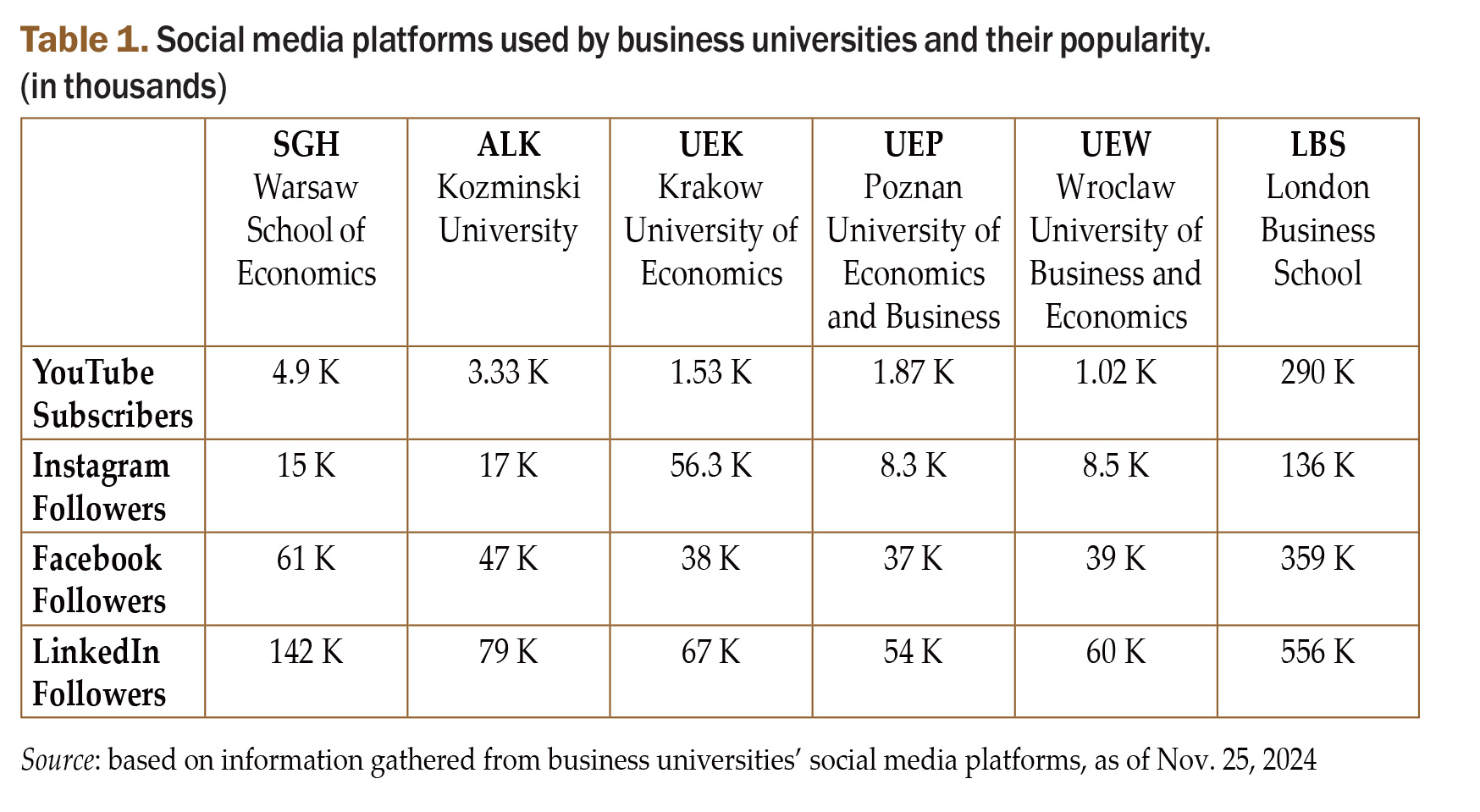
The aim of the analysis is to identify how these institutions use video marketing as part of their marketing strategies on social media platforms. By comparing marketing activities, this study seeks to identify best practices and areas for improvement, which can ultimately serve as a valuable resource for universities seeking to optimize their video marketing strategies.
The following sections of this article will discuss the marketing activities of each of the selected universities, with a particular focus on their specific approach to video marketing. This examination will not only shed light on the individual strategies employed by these institutions, but also seeks to capture wider trends and challenges in the use of video for social media marketing in the education sector.
5. Evaluating the video marketing performance of selected universities
In the context of universities and colleges, video marketing serves several functions. First and foremost, it allows for effective presentation of the educational offerings, infrastructure and academic life to prospective students. In addition, it enables the university to project an image as a modern and dynamic institution capable of meeting the challenges of the contemporary educational market. Beyond recruitment, video marketing is also an important tool in building emotional ties with current students, alumni and business partners.
To provide a structured analysis, four main aspects of video marketing activities have been selected for benchmarking: 1) presentations of the campus and infrastructure, 2) interviews with lecturers and students, 3) recordings of cultural and scientific events and 4) short promotional videos presenting the unique features and advantages of the university.
5.1. Campus and infrastructure presentations
Campus and infrastructure presentations are a key element of video marketing, as they allow prospective students and other stakeholders to experience the physical environment of the university. Showcasing the ensemble of campus facilities, lecture theatres, laboratories and recreational spaces can increase the attractiveness of the university and influence decisions on where to study.
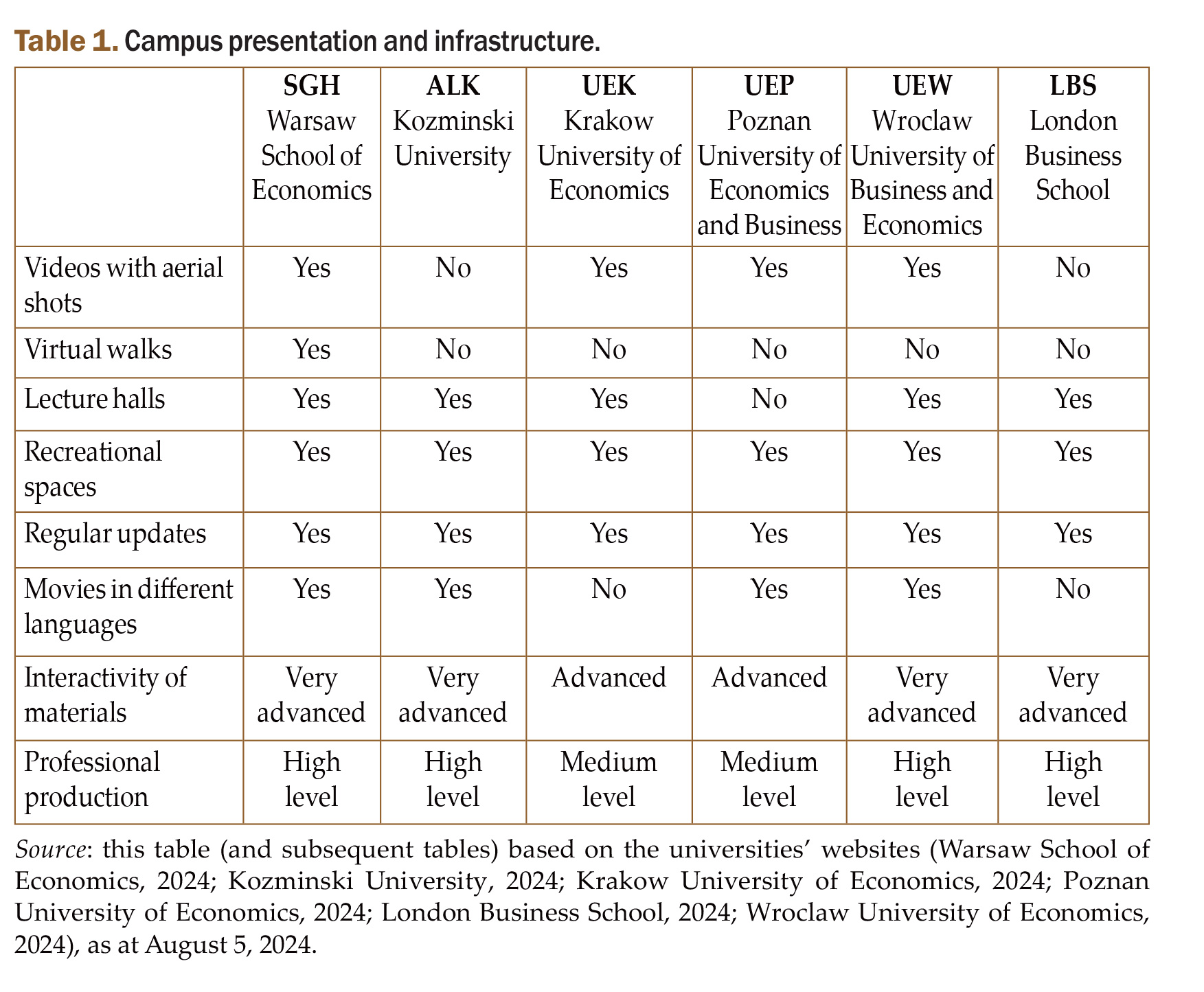
As the comparative analysis shows, most of the Polish business universities examined, including SGH, UEK, UEP and UEW, actively use video marketing to present their campuses and infrastructure. All these universities regularly update their video materials, which is crucial to maintaining an up-to-date image in the eyes of prospective students. However, only SGH offers virtual tours, which distinguishes it from other universities (suggesting an opportunity for the latter to further develop their online presentation tools).
In terms of interactivity and professionalism of production, all the universities exhibit a commendable level of quality, but SGH, KU and UEW stand out for the particularly advanced interactivity of their materials. Multilingual video content is available from most of the Polish universities, although CUE could broaden its global reach by incorporating this feature. London Business School, although it does not offer virtual tours or videos with aerial shots, compensates for this with very advanced interactivity of materials and a high level of professionalism in production, which puts it at the forefront in terms of global video marketing standards.
In sum, while all the business universities analyzed do use video marketing effectively, features such as advanced interactivity, professional production and the availability of materials in various languages determine their effectiveness on the global educational market. The Polish business universities have a strong position, but they can still benefit from further optimization of their strategies, drawing inspiration from institutions such as London Business School.
5.2. Interviews with lecturers and students
Interviews with lecturers and students are an effective video marketing tool, focusing on the human side of the university. Such videos highlight not only scientific and teaching achievements, but also personal experiences and stories. Such content can build emotional bonds with current and future students and increase the university’s credibility and appeal.
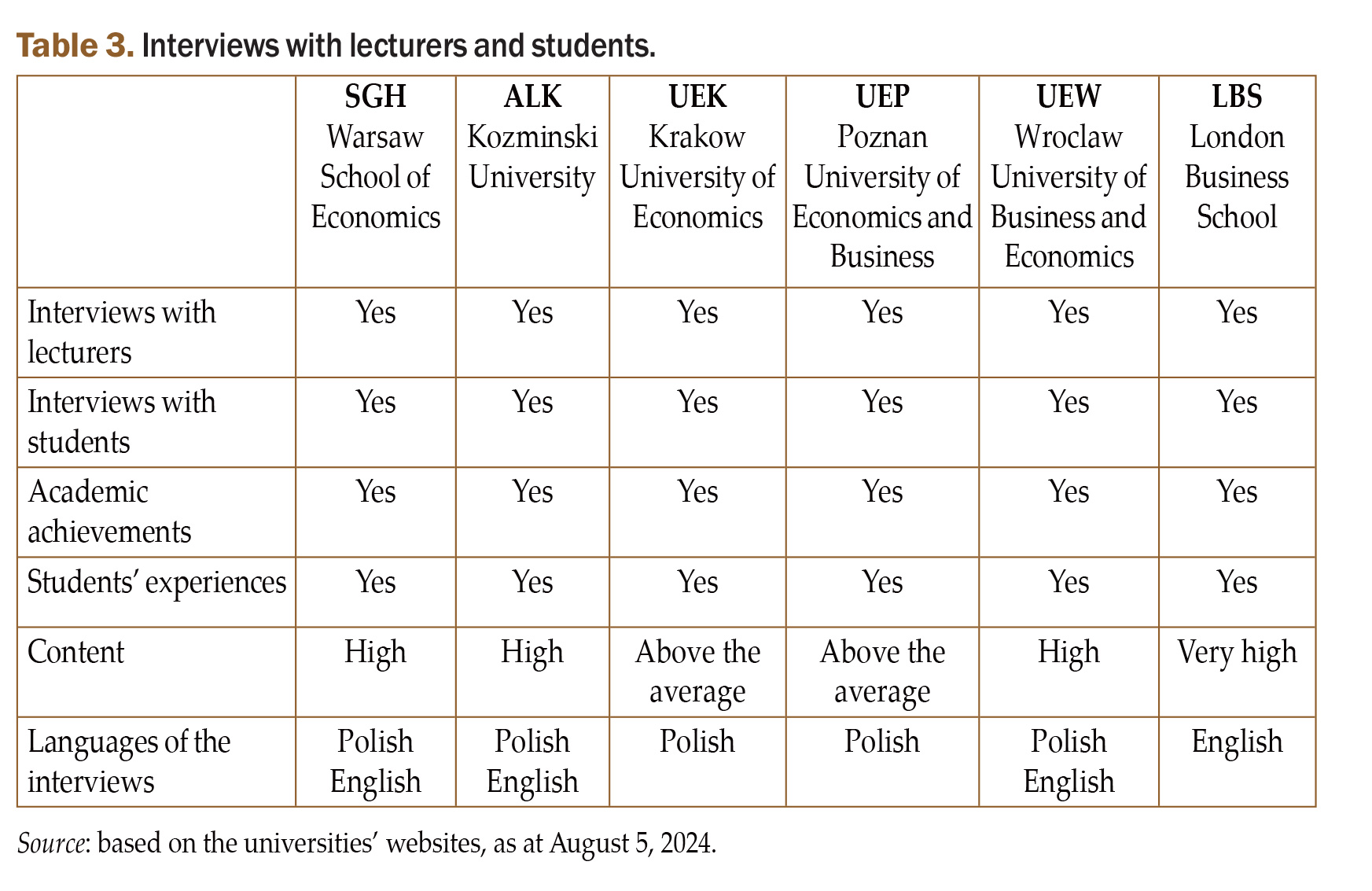
This comparative analysis indicates that all the business universities analyzed – both the Polish institutions and London Business School – regularly publish interviews with faculty members and students. Such interviews effectively highlight both scientific achievements and student experiences, a common element that helps to build the image of the university as an academic institution of high standards.
Here again, London Business School clearly stands out in terms of content quality and the multilingual nature of its interviews, which contributes to its global success and wide reach. Polish universities, such as SGH, ALK, and UEW, are also well-rated, especially in terms of content quality and the availability of interviews in English, which helps them attract international students. UEK and UEP have room for improvement, particularly in terms of enhancing content quality and expanding their reach by publishing interviews in additional languages. Integrating these elements could strengthen their position on the international stage.
In summary, although Polish business universities demonstrate solid foundations in video marketing, there is still room for improvement in terms of content and language, which could bolster their competitive position in the global educational environment.
5.3. Recordings of cultural and scientific events
Recordings of cultural and scientific events are essential for building a university’s image as a dynamic and active academic center. Coverage of conferences, open days, festivals, and other events allows the university to be showcased in the context of its activities beyond strictly educational ones, which can increase interest from students, staff, and external partners.
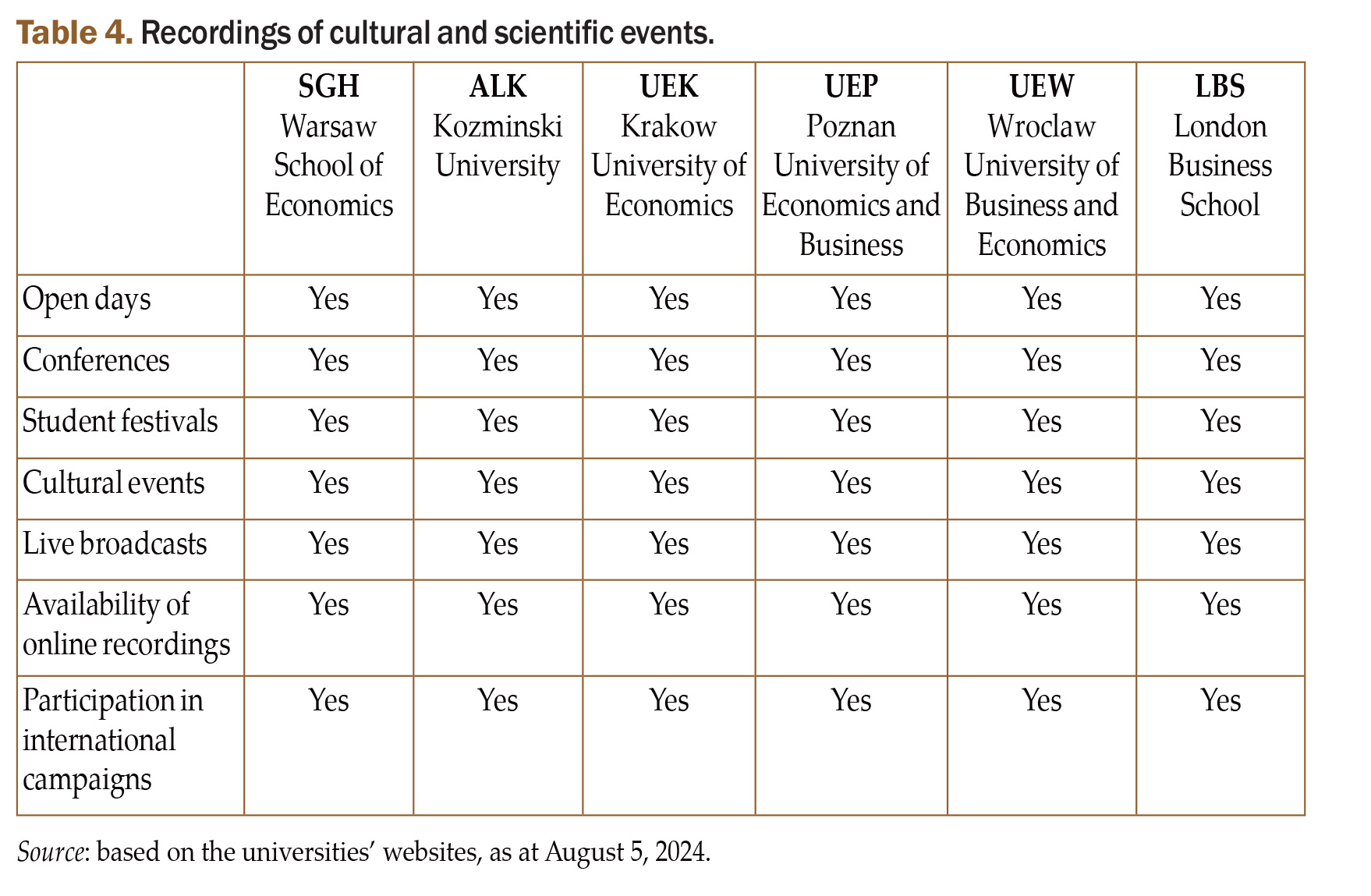
This comparative analysis shows that all the analyzed business universities analyzed – both the Polish institutions and London Business School – actively participate in organizing and documenting conferences, open days, student festivals, and cultural events. All the universities conduct live broadcasts and provide online recordings of these events, which increases their accessibility and reach. London Business School and most Polish universities, including SGH, ALK, UEK, and UEW, actively participate in such campaigns, which strengthens their global presence and attracts international students. UEP, although active at the local level, does not engage in international campaigns, which may limit its reach and impact in the global education market. This shows that while UEP operates effectively at the national level, its development on the international stage may require additional efforts.
5.4. Short promotional videos highlighting the unique features and advantages of the university
Short promotional videos are an important tool in video marketing as they allow for the quick and effective presentation of a university’s unique features and advantages. They can effectively capture the attention of prospective students by showcasing the educational offerings, scientific achievements, and alumni successes in an appealing way.
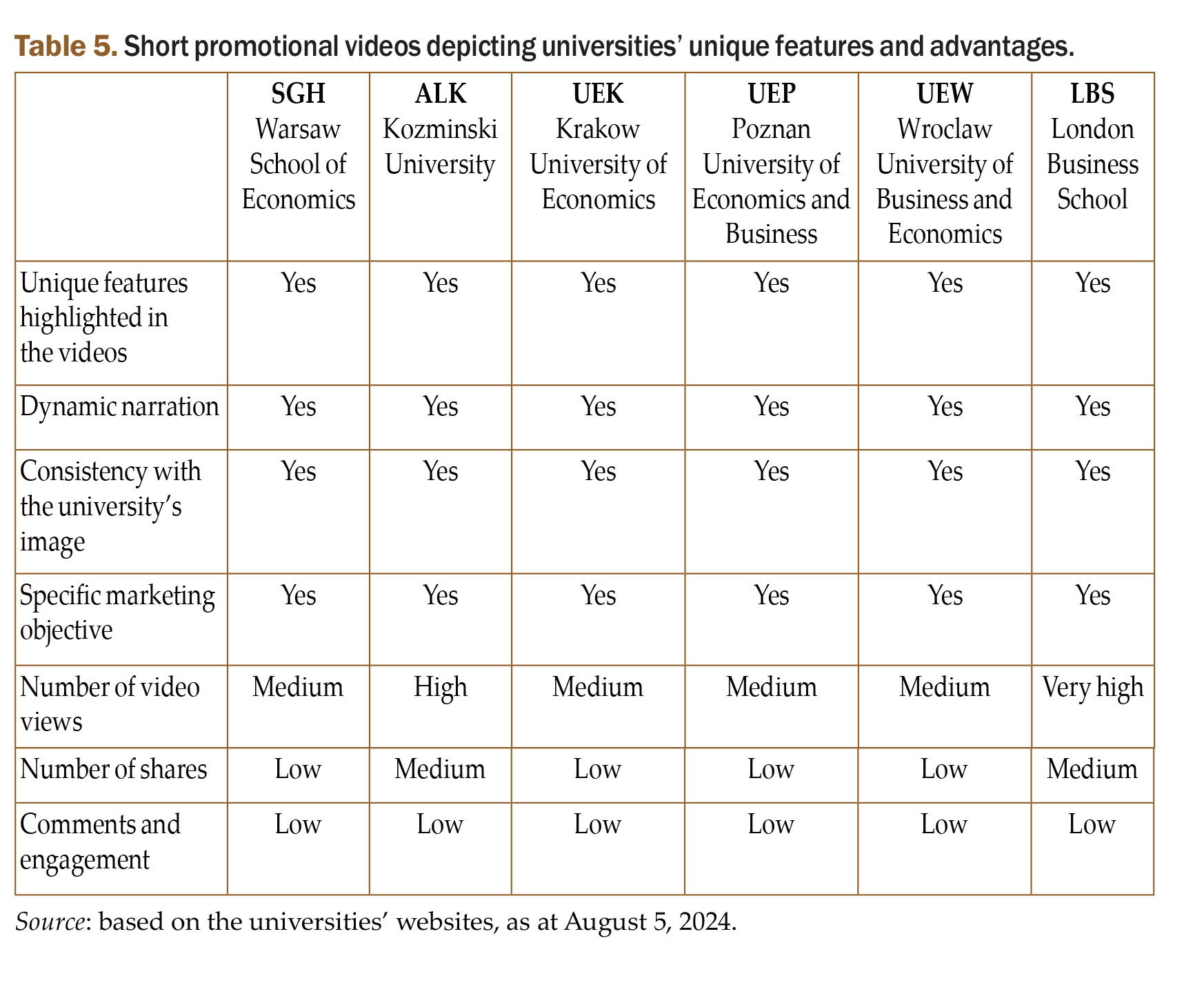
Comparative analysis of this data indicates that all the business universities analyzed – both the Polish institutions and London Business School – effectively use video marketing to highlight their unique features, while maintaining consistency with the university’s image and dynamic narrative. However, differences emerge in terms of effectiveness in reaching a wide audience.
LBS yet again stands out significantly in terms of number of impressions, scoring very high, indicating its strong global position and reach. Among Polish universities, ALK achieves the highest number of impressions, suggesting that its video marketing strategy is more effective than those of SGH, UEK, UEP and UEW, which score only medium numbers of impressions.
In terms of the number of shares and community engagement, all of the universities analyzed, including LBS, have relatively low levels of engagement, which may indicate a need to better tailor video content to viewers’ preferences and expectations. The Polish business universities, in particular, could focus on improving the appeal of content to better engage viewers and encourage them to interact and share videos.
6. Conclusions and recommendations
Overall, this comparative analysis of video marketing at five leading Polish business schools and the London Business School (LBS) offers certain conclusions about the effectiveness of these activities and highlights areas for further development.
First, all of the universities analyzed make effective use of video marketing to showcase their campus, infrastructure and recreational spaces, which is key to building their image and attracting prospective students. SGH differentiates itself from other Polish universities by offering virtual walk-throughs of the campus, which increases accessibility and allows students to get an in-depth look at the university without being physically present. This approach is particularly attractive to international students, who can remotely tour the campus and learn about its facilities. London Business School, while not using virtual walk-throughs or bird’s-eye shots, focuses on using advanced technology and dynamic narratives in its videos. This strategy allows LBS to capture viewers’ attention on a global level and highlight its position as one of the world’s leading business schools.
Secondly, in terms of interviews with faculty and students, all universities regularly publish this kind of content, which is an important part of building relationships with audiences and showcasing academic achievements and student experiences. London Business School stands out for the highest quality content of these materials, which underscores its global prestige. In addition, LBS publishes interviews in multiple languages, which makes them more accessible to an international audience and allows it to attract students from different parts of the world. In Poland, SGH, ALK and UEW also offer interviews in English, which increases their international appeal. However, UEK and UEP only publish interviews in Polish, which may limit their global reach and prevent them from reaching a wider range of prospective international students.
Third, coverage of cultural and scientific events is well developed at all the universities analyzed. Both LBS and the Polish institutions analyzed provide live broadcasts of these events and ensure the availability of online records, which allows them to reach a wider audience, including those who could not attend live events. This practice increases the involvement of the academic community and highlights the university’s activity in organizing various cultural and scientific initiatives. It is also worth noting that participation in international campaigns is an important part of London Business School’s marketing strategy, which contributes to building its global brand and attracting students from all over the world. In Poland, SGH, ALK and UEW are also involved in such campaigns, which strengthens their international reach and prestige. However, UEP, while active at the national level, does not participate in international campaigns, which may limit its reach and ability to reach the global academic community. In the long term, this could affect its competitiveness in the international market and limit its ability to attract international students and partners.
Fourth, in terms of numbers of subscribers and social media reach, London Business School definitely stands out as a global leader, which is a testament to its effective marketing efforts and strong position in the education market. LBS effectively uses a variety of communication channels to reach a wide audience, which translates into very high results in terms of both the number of subscribers and reach. In Poland, ALK and UEW also score high in these areas, which demonstrates their ability to run effective marketing campaigns and build an engaged community around their brands. SGH, UEK and UEP, on the other hand, are performing at an average level, suggesting the need to intensify promotional activities in social media. Better content targeting and more intensified campaigns could help increase audience reach and engagement, which could consequently improve their position in the market.
Importantly, Polish universities such as UEK and UEP should consider publishing video materials in English and other foreign languages to increase their international reach. Increasing the number of multilingual materials could help attract more international students and partners. Additionally, UEP, which does not participate in international campaigns, could strengthen its international presence by engaging in such initiatives. Developments in this area could help increase the university’s visibility in the global marketplace and build its prestige. The other Polish universities, such as SGH, ALK and UEW, should continue their activities while intensifying their social media promotion, which would allow them to achieve better results in terms of number of subscribers and reach. Strengthening their online presence and increasing audience engagement could further increase their appeal in the international market. Developing these areas is crucial for strengthening the position of Polish universities in the global education market and for increasing their competitiveness in attracting international students and academic partners.
To further enhance the effectiveness of the video marketing efforts of Polish business universities, some key strategies are recommended:
- Introducing more interactive content, such as live Q&A sessions, could significantly increase audience engagement. Interactive content allows direct communication with prospective students, answering their questions and concerns in real time, which can increase their engagement and trust in the university.
- Regularly publishing new video content is key to keeping the academic community and college applicants interested and engaged. Updating content, especially in the context of rapidly changing market and technological conditions, keeps audiences informed of the university’s news and achievements.
- Expanding reach by working with educational influencers and promoting video content on international social media platforms can help increase the university’s global visibility. Educational influencers can effectively promote the university to their many followers, which increases the reach and impact of marketing efforts. International social media platforms, such as YouTube and Instagram, allow a wide and diverse audience to be reached, which is especially important for recruiting international students.
- Creating personalized video content targeting different audiences, such as college applicants, current students, alumni and business partners, can significantly improve the effectiveness of marketing communications. It would be worthwhile to expand video marketing efforts with prominent alumni and business leaders, hailing from the business university and co-creating its brand. Personalizing content allows the message to be better tailored to the specific needs and expectations of different audiences, which increases their engagement and satisfaction.
References
Berman, S., Marshall, A. (2014). The next digital transformation: from an individual centered to an everyone-to-everyone economy. Strategy & Leadership, 42(5), 9–17.
Butov, E., Herman, E.J., Liu, S., Robinson, A. (2020). Ultimate Guide to Social Media Marketing. Entrepreneur Press.
Cheung M.L., Pires G.D., Rosenberger P.J. (2019). Developing a conceptual model for examining social media marketing effects on brand awareness and brand image. Economics and Business Research, 17(3), 243–261.
Daniłoś, M. (2016). Video marketing nie tylko na Youtube [Video marketing not just on YouTube]. Wydawnictwo Helion.
Flannery, T. (2021). How to Market a University. Johns Hopkins University Press
Grębosz M., Siuda D., Szymański G. (2016). Social Media Marketing. Wydawnictwo Politechniki Łódzkiej.
Hess, T., Matt, C., Benlian, A., Wiesböck, F. (2016). Options for Formulating a Digital Transformation Strategy. MIS Quarterly Executive, 15/2(131), 123–139.
Hill, R., (2023). Social Media Marketing 2024: Mastering New Trends & Strategies for Online Success. Amazon Independently published.
Kotler P., Armstrong G. (2022). Marketing: Wprowadzenie [Marketing: An Introduction]. Wydawnictwo Nieoczywiste.
Kopera, S. (Red.) (2022). Media społecznościowe i ich wpływ na zachowania konsumenckie [Social media and their impact on consumer behavior]. Instytut Przedsiębiorczości Uniwersytetu Jagiellońskiego.
Królewski, J., Sala, P. (red.). (2021). E-marketing: współczesne trendy: pakiet startowy [E-marketing: Contemporary trends: A starter pack]. PWN.
Miller, M. (2011). You Tube for business. Online video marketing for any business. Pearson Education.
Reed, J. (2010). Get Up to Speed with Online Marketing: How to Use Websites, Blogs, Social Networking and Much More. Prentice Hall.
Skwarek, M. (2022). Skuteczny marketing na Tik Toku: jak zdobyć miliony wyświetleń i tysiące obserwatorów w miesiąc (albo szybciej) [Effective marketing on TikTok: How to get millions of views and thousands of followers in a month (or less)]. Wydawnictwo Helion.
Stawarz, B. (2017). Content Marketing i Social Media [Content Marketing and Social Media]. Wydawnictwo Naukowe PWN.
Stępowski, R. (2017). Video marketing w mediach społecznościowych, czyli kieszenie pełne telewizji [Video marketing in social media, or pockets full of television]. Wydawnictwo Roster.
Syska M., Ożadowicz A., Kolenda P. red. (2018). Poradnik wideo marketingu [Video marketing guidebook]. IAB.Polska.
Świerczyńska-Kaczor, U. (2012). E-marketing przedsiębiorstwa w społeczności wirtualnej [E-marketing of the enterprise in a virtual community]. Wydawnictwo Difin.
Tarczydło, B. (2017). Wideomarketing w teorii i praktyce: Wyniki badań. [Video marketing in theory and practice: Research results]. Handel wewnętrzny, 6 (371).
Tobiasz, M., Szymański, W. (2016). Content marketing, współczesny poradnik po marketingu treści [Content marketing: A contemporary guide to content marketing]. Newsline.
Turner, J., & Shah, R. (2011). How to Make Money with Social Media: An Insider’s Guide on Using New and Emerging Media to Grow Your Business. Que Publishing.
Verhoef, P. C., Broekhuizen, T., Bart, Y., Bhattacharya, A., Qi Dong, J., Fabian, N., Haenlein, M. (2021). Digital Transformation: A Multidisciplinary Reflection and Research Agenda. Journal of Business Research, 122, 889–901.
Other sources:
Kozminski University. (2024). Homepage. Kozminski – #1 business university in Central Europe. Retrieved August 5, 2024, from https://www.kozminski.edu.pl
Krakow University of Economics. (2024). Homepage. Retrieved August 5, 2024, from
https://www.uek.krakow.pl
London Business School. (2024). Homepage. Retrieved August 5, 2024, from https://www.london.edu
Poznan University of Economics. (2024). Homepage. Retrieved August 5, 2024, from
https://www.ue.poznan.pl
Warsaw School of Economics. (2024). Homepage. SGH. Retrieved August 5, 2024, from
https://www.sgh.waw.pl
Wroclaw University of Economics. (2024). Homepage. Best Economic Studies. Retrieved August 5, 2024, from https://www.ue.wroc.pl
Mirosława Pluta-Olearnik is a full professor at the Wroclaw University of Economics and Business. She is a professor of economics, service management, marketing. She is the author of a number of books, including Marketing Usług [Marketing of Services] and Marketing przedsiębiorstw usługowych w procesie internacjonalizacji [Marketing of service enterprises in the internationalization process]. She is also the author of numerous research papers and a moderator of discussions at conferences in the fields of economics, management, and marketing.
Alisa Hasiak is a graduate of the Management Faculty at the University of Economics in Wrocław (2024). She is interested in the field of creative communication, internet marketing, and public relations. She developed her interests during her studies and prepared her master thesis in cooperation with the Marketing Department in 2024. She is currently developing professionally in the field of rankings and scientific communication, working as a specialist at the Wroclaw Medical University, where she promotes scientists and popularizes science.

